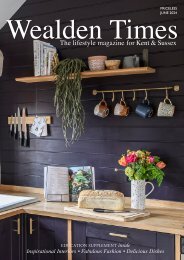Surrey Homes | SH79 | August 2021 | Adding value to your property supplement inside
The lifestyle magazine for Surrey - Inspirational Interiors, Fabulous Fashion, Delicious Dishes
The lifestyle magazine for Surrey - Inspirational Interiors, Fabulous Fashion, Delicious Dishes
- No tags were found...
Create successful ePaper yourself
Turn your PDF publications into a flip-book with our unique Google optimized e-Paper software.
camassia<br />
Jo Arnell gets ahead of the bulb game with fuss-free<br />
picks for every part of the garden<br />
I<br />
had an aunt who, as soon as the longest day was over, would start talking about<br />
Christmas. “The nights are drawing in,” she would say before we’d even broken up<br />
for the summer holidays. It feels a bit like that talking about bulbs right now, as if I’m<br />
wishing the rest of the summer away and heading straight in<strong>to</strong> the squirrelling months<br />
of autumn. It seems weird <strong>to</strong> be preparing for next year already. But, just as the seed<br />
catalogues thud through the letter box in January, when it’s far <strong>to</strong>o cold and dark <strong>to</strong> sow<br />
seed, so the bulb books arrive in July, when preparing for a spring spectacular is far from<br />
our minds. I am not usually drawn in<strong>to</strong> placing early orders for bulbs, but this year, for<br />
varied reasons, there may be glitches in the supply, so it might pay <strong>to</strong> start thinking early.<br />
We tend <strong>to</strong> lump all the spring bulbs <strong>to</strong>gether, so that – in our minds – and in the<br />
garden centres, there is a happy throng of glorious colour that just needs <strong>to</strong> be planted<br />
in the ground in the autumn for a guaranteed show the following year. Most of the<br />
time this will work – in the first year at least. Bulbs are forgiving little packages of<br />
squashed up stem, leaf and flower, primed by their breeders <strong>to</strong> not need much more<br />
than a bit of a substrate and water <strong>to</strong> get them <strong>to</strong> grow and bloom. In fact many of<br />
the forced bulbs, like prepared Hyacinths and Paperwhites, will happily do so in a slim<br />
necked vase of water. It is magical <strong>to</strong> watch them grow roots and unfurl before our<br />
eyes, shooting up <strong>to</strong> bloom and cheer us in the darkest, shortest days. This is fine for<br />
a short term fix – they are treated like a cut flower that we grow ourselves – and then,<br />
if we remember, planted outside somewhere <strong>to</strong> flower again. If we want our outdoor<br />
show <strong>to</strong> be reliable and continue performing well, it helps <strong>to</strong> know that not all bulbs<br />
are the same. They are often from different environments, even from opposite parts of<br />
the world. If you are planting <strong>your</strong> bulbs directly in<strong>to</strong> the ground, rather than in pots<br />
and want them <strong>to</strong> thrive, then it’s worth thinking about the conditions they need.<br />
All bulbs have evolved <strong>to</strong> cope with situations that are tricky for part of the<br />
year. It is hard <strong>to</strong> hang on in there if there’s no rain, or if you are plunged in<strong>to</strong><br />
shade for eight months of the year. These clever plants are able <strong>to</strong> make the<br />
most of early spring rains or the brief time when the trees have no leaves, by<br />
popping up and flowering in a rush. When the conditions change they are able<br />
<strong>to</strong> retreat back under the ground, put themselves in<strong>to</strong> s<strong>to</strong>rage and wait for their<br />
moment <strong>to</strong> return. The thing <strong>to</strong> remember is which type of impossible growing<br />
conditions they are trying <strong>to</strong> avoid – heat and drought, or extreme shade.<br />
yellow<br />
crocus<br />
fritillaries<br />
Extra images: is<strong>to</strong>ck.com/popovapho<strong>to</strong> / vicuschka / pho<strong>to</strong>danila<br />
Woodland bulbs have timed their flowering <strong>to</strong> coincide with the cycles in deciduous<br />
forests and woods. They will often be the earliest <strong>to</strong> flower, shooting in<strong>to</strong> growth before<br />
the dense canopy of leaves starts <strong>to</strong> grow over them and block out their light. They<br />
will prefer <strong>to</strong> grow in humus rich soil, in semi-shade and won’t mind the dampness of<br />
the winter. The woodlanders are also good at naturalising – spreading out in a carpet<br />
between the trees. Snowdrops, bluebells, dog’s <strong>to</strong>oth violets, and wood anemones are<br />
found in these situations. They do not like <strong>to</strong> dry out, which is why you often see<br />
them for sale ‘in the green’, so that they can be planted straight after they flower.<br />
Meadow dwellers, such as narcissi and crocus will happily naturalise in grassy areas.<br />
These will grow almost anywhere, but Snake’s Head Fritillaries and the later flowering<br />
Camassias appreciate a damp meadow, and won’t mind areas of cold wet clay. Bulbs from<br />
more arid places will rot in such conditions, which partly explains why tulips – originally<br />
from mountainous regions in Turkey and Iran where summers are hot and dry, find it<br />
hard <strong>to</strong> keep going. Tulips need a sunny and very free draining position and will not<br />
enjoy sitting through the winter with wet, soggy bot<strong>to</strong>ms (I’m with them there). <br />
109 priceless-magazines.com


















